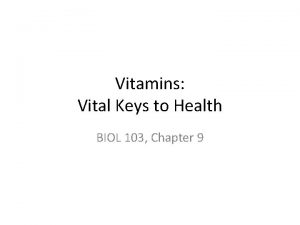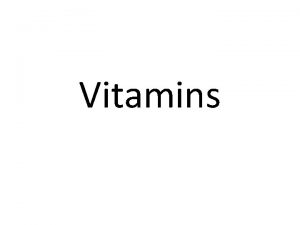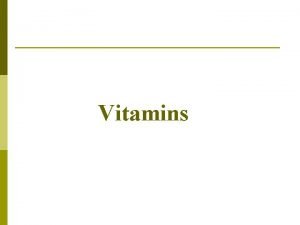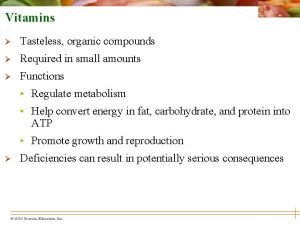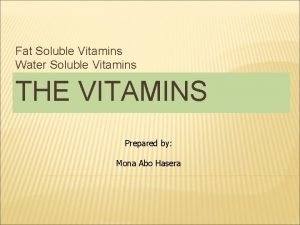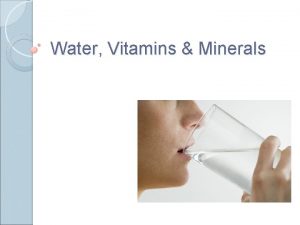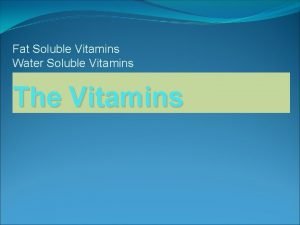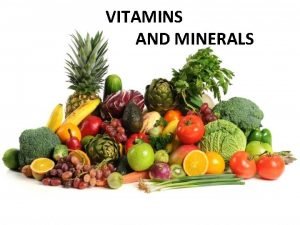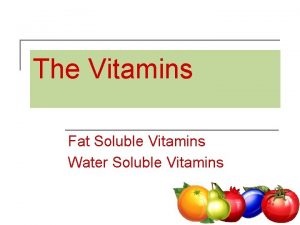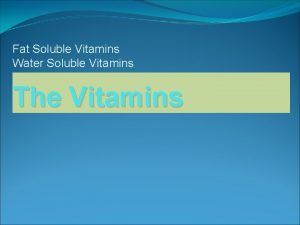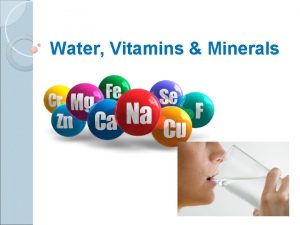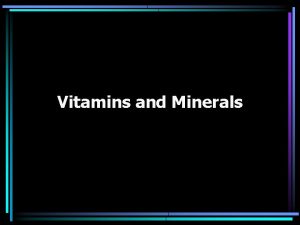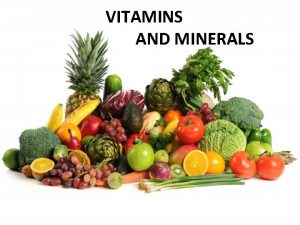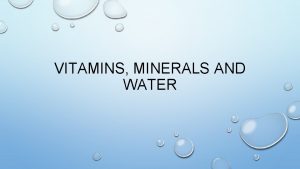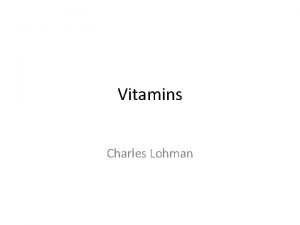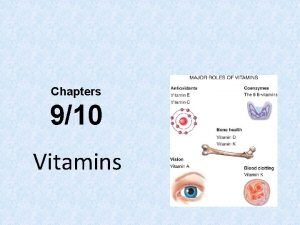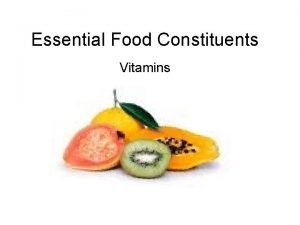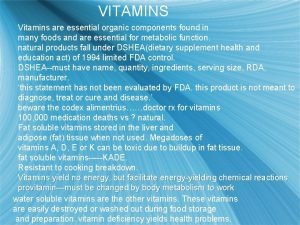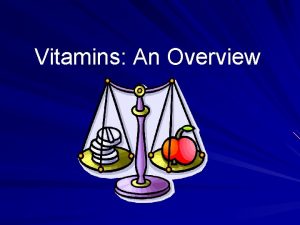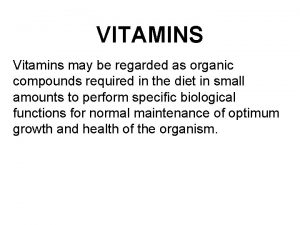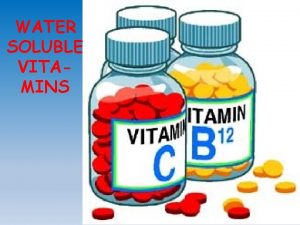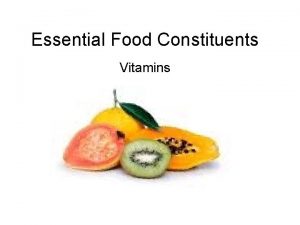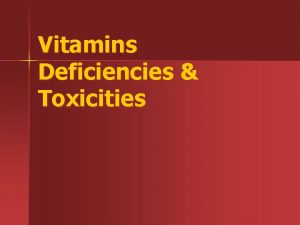Chapters 10 11 THE VITAMINS Vitamins Vitamins organic






























- Slides: 30

Chapters 10 & 11 THE VITAMINS

Vitamins • Vitamins – organic nutrients required in trace amounts • Essential to the regulation of body processes • Noncaloric • Divided into 2 groups based on solubility: Fat-soluble & Watersoluble

The Fat-Soluble Vitamins Copyright 2005 Wadsworth Group, a division of Thomson Learning

Vitamin A • Other names – Retinol – Retinal – Retinoic acid – Precursors are carotenoids such as beta-carotene made by plants Copyright 2005 Wadsworth Group, a division of Thomson Learning

Vitamin A & Beta-Carotene Copyright 2005 Wadsworth Group, a division of Thomson Learning

Vitamin A • Chief functions in the body – Vision – Maintenance of cornea, epithelial cells, mucous membranes, skin – Bone and tooth growth – Reproduction – Immunity – Beta-carotene as an antioxidant (may help prevent cancer & heart disease) Copyright 2005 Wadsworth Group, a division of Thomson Learning

Vitamin A • Chief functions in the body – Vision – Maintenance of cornea, epithelial cells, mucous membranes, skin – Bone and tooth growth – Reproduction – Immunity – Beta-carotene as an antioxidant (may help prevent cancer & heart disease) Copyright 2005 Wadsworth Group, a division of Thomson Learning

Beta-Carotene The color of Vitamin A foods - spinach and other dark leafy greens; broccoli, deep orange fruits (apricots, cantaloupe) and vegetables (squash, carrots, sweet potatoes, pumpkin) Copyright 2005 Wadsworth Group, a division of Thomson Learning

Vitamin A • Significant sources – Retinol: fortified milk, cheese, cream, butter, fortified margarine, eggs, liver • 2001 RDA – Men: 900 g/day – Women: 700 g/day Copyright 2005 Wadsworth Group, a division of Thomson Learning

Vitamin A Deficiency symptoms – Night blindness - leading cause of childhood blindness in world – corneal drying (xerosis) – triangular gray spots on eye (Bitot’s spots) – softening of the cornea (keratomalacia) – corneal degeneration and blindness (xerophthalmia) – Impaired immunity (infections) – Plugging of hair follicles with keratin, forming white lumps (hyperkeratosis) Copyright 2005 Wadsworth Group, a division of Thomson Learning

Vitamin A • Upper level for adults: 3000 g/day Excess preformed may be toxic but excess beta-carotene is not toxic • Acute toxicity symptoms – Blurred vision – Nausea, vomiting, vertigo – Increase of pressure inside skull, mimicking brain tumor – Headaches • Chronic toxicity symptoms – Increased activity of osteoclasts causing reduced bone density – Liver abnormalities – Birth defects Copyright 2005 Wadsworth Group, a division of Thomson Learning

Vitamin D • Other names – the “sunshine” vitamin – Calciferol – 1, 25 -dihydroxy vitamin D (calcitriol) – Animal version: vitamin D 3 or cholecalciferol – Plant version: vitamin D 2 or ergocalciferol – Precursor is the body’s own cholesterol Copyright 2005 Wadsworth Group, a division of Thomson Learning

Vitamin D • Chief functions in the body – Mineralization of bones (raises blood calcium and phosphorus by increasing absorption from digestive tract, withdrawing calcium from bones, stimulating retention by kidneys) Copyright 2005 Wadsworth Group, a division of Thomson Learning

Vitamin D • Significant sources – Synthesized in the body with the help of sunlight – Fortified milk, margarine, butter, cereals, and chocolate mixes – Veal, beef, egg yolks, liver, fatty fish (herring, salmon, sardines) and their oils Copyright 2005 Wadsworth Group, a division of Thomson Learning


Vitamin D • 1997 adequate intake (AI) – 19 -50 years: 5 g/day – 51 -70 years: 10 g/day – more than 70 years: 15 g/day • Upper level for adults: 50 g/day Copyright 2005 Wadsworth Group, a division of Thomson Learning

Vitamin D • Deficiency symptoms: rickets in children – Inadequate calcification, resulting in misshapen bones (bowing of legs) – Enlargement of ends of long bones (knees, wrists) – Deformities of ribs (bowed, with beads or knobs) – Delayed closing of fontanel, resulting in rapid enlargement of head Copyright 2005 Wadsworth Group, a division of Thomson Learning

Vitamin D • Deficiency disease in children – Rickets Copyright 2005 Wadsworth Group, a division of Thomson Learning

Vitamin D • Deficiency symptoms in adults: -Osteomalacia -Loss of calcium, resulting in soft, flexible, brittle , and deformed bones – Progressive weakness – Pain in pelvis, lower back, and legs Copyright 2005 Wadsworth Group, a division of Thomson Learning

Vitamin D • Toxicity symptoms – Elevated blood calcium – Calcification of soft tissues (blood vessels, kidneys, heart, lungs, tissues around joints) – Frequent urination Copyright 2005 Wadsworth Group, a division of Thomson Learning

Vitamin E • Other name: alpha-tocopherol • Chief function in the body – Antioxidant (stabilization of cell membranes, regulation of oxidation reactions, protection of polyunsaturated fatty acids and vitamin A) effect in lungs, protection against heart disease, helps relieve fibrocystic breast disease Copyright 2005 Wadsworth Group, a division of Thomson Learning

Vitamin E Copyright 2005 Wadsworth Group, a division of Thomson Learning

Vitamin E • 2000 RDA –Adults: 15 mg/day • Upper level for adults: 1000 mg/day

Vitamin E • Significant sources – Polyunsaturated plant oils (margarine, salad dressings, shortenings) – Leafy green vegetables, wheat germ, whole grains, liver, egg yolks, nuts, seeds Copyright 2005 Wadsworth Group, a division of Thomson Learning

Vitamin E • Easily destroyed by heat and oxygen • Deficiency symptoms – Red blood cell breakage (erythrocyte hemolysis) – Nerve damage • Toxicity symptoms – Interfers with blood clotting & augments the effects of anticoagulants Copyright 2005 Wadsworth Group, a division of Thomson Learning

Vitamin K • Other names – Phylloquinone – Menadione – Naphthoquinone Copyright 2005 Wadsworth Group, a division of Thomson Learning

Vitamin K • Chief functions in the body – Synthesis of blood-clotting proteins and bone proteins that regulate blood calcium Copyright 2005 Wadsworth Group, a division of Thomson Learning

Vitamin K • 2001 AI –Men: 120 g/day –Women: 90 g/day

Vitamin K • Significant sources – Bacterial synthesis in the digestive tract – Liver – Leafy green vegetables, cabbage-type vegetables – Milk Copyright 2005 Wadsworth Group, a division of Thomson Learning

Vitamin K • Deficiency symptoms: - Hemorrhagic disease (blood fails to clot) - Can occur with long-term use of antibiotics & newborns (Vit. K usually given at birth) • Toxicity symptoms: - Causes RBC hemolysis & jaundice - Interferes with effectiveness of anticoagulants Copyright 2005 Wadsworth Group, a division of Thomson Learning
 Water soluble vitamins vs fat soluble vitamins
Water soluble vitamins vs fat soluble vitamins Vitamin flowchart
Vitamin flowchart Hemoragea
Hemoragea Celiac beri beri
Celiac beri beri Absorption of water soluble vitamins
Absorption of water soluble vitamins Mật thư tọa độ 5x5
Mật thư tọa độ 5x5 Tư thế ngồi viết
Tư thế ngồi viết Ví dụ giọng cùng tên
Ví dụ giọng cùng tên Chó sói
Chó sói Thẻ vin
Thẻ vin Thơ thất ngôn tứ tuyệt đường luật
Thơ thất ngôn tứ tuyệt đường luật Hươu thường đẻ mỗi lứa mấy con
Hươu thường đẻ mỗi lứa mấy con Từ ngữ thể hiện lòng nhân hậu
Từ ngữ thể hiện lòng nhân hậu Thế nào là hệ số cao nhất
Thế nào là hệ số cao nhất Diễn thế sinh thái là
Diễn thế sinh thái là Ng-html
Ng-html Vẽ hình chiếu vuông góc của vật thể sau
Vẽ hình chiếu vuông góc của vật thể sau Làm thế nào để 102-1=99
Làm thế nào để 102-1=99 Lời thề hippocrates
Lời thề hippocrates Vẽ hình chiếu đứng bằng cạnh của vật thể
Vẽ hình chiếu đứng bằng cạnh của vật thể Tư thế worm breton là gì
Tư thế worm breton là gì đại từ thay thế
đại từ thay thế Quá trình desamine hóa có thể tạo ra
Quá trình desamine hóa có thể tạo ra Công thức tính độ biến thiên đông lượng
Công thức tính độ biến thiên đông lượng Khi nào hổ con có thể sống độc lập
Khi nào hổ con có thể sống độc lập Thế nào là mạng điện lắp đặt kiểu nổi
Thế nào là mạng điện lắp đặt kiểu nổi Các châu lục và đại dương trên thế giới
Các châu lục và đại dương trên thế giới Dot
Dot Biện pháp chống mỏi cơ
Biện pháp chống mỏi cơ Bổ thể
Bổ thể độ dài liên kết
độ dài liên kết
